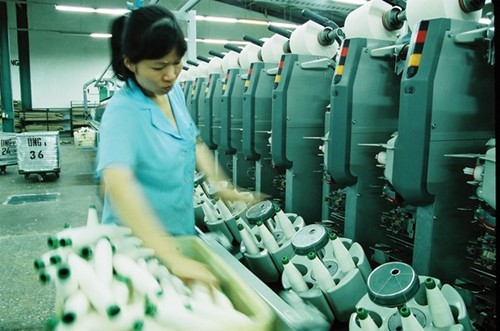(VOVworld) – In the 5 years of a program urging Vietnamese people to prioritize made-in-Vietnam goods, domestically manufactured garments and textiles have become more popular with consumers. Meanwhile garment enterprises have increased their investment in production and expanded their distribution system to gain market share.
The Trans-Pacific Partnership agreement, which is likely to be signed by the end of this year, will open many opportunities for Vietnam’s garment and textile exports. In addition to expanding export markets, the sector is hoping to gain a larger share of the domestic market.
 |
| Five more domestic textile and garment companies have piloted Petrochemical and Textile Fibre Joint Stock Company’s fibers. PVTEX has recently invested 324 million USD in building Dinh Vu Polyester Fiber Plant with a designed capacity of 150,000 tons yearly. (Photo: tintucchungkhoan.vn) |
In the first six months of this year, domestic revenues of the Vietnam National Textile and Garment Group (Vinatex) were nearly 520 million USD, up 10% over last year. Nguyen Tien Truong, Vinatex’s Deputy Director General, said this year the group is hoping to increase total revenue 12%, of which 30% will be from domestic sales. Truong comments: “for a consecutive decade, Vinatex has paid a lot of attention to the domestic market because we understand that it can take time to create a buying habit among consumers. They need time to become familiar with, choose, and become loyal to domestically-made items. So although the domestic market has faced many difficulties over the past 3 years, with an overall decline in buying, we keep developing the group’s system of supermarkets by expanding chains of specialized shops for each brand.”

Vietnam is estimated to earn 13.65 billion USD from garment and textile exports over the past 8 months of 2014 (Photo: tintucchungkhoan.vn)
|
Vinatex and its members are speeding up the expansion of the domestic market. The group now has more than 4,000 shops, agents, and distributors nationwide offering 60,000 domestically-made items. Nguyen Thi Thanh Huyen, Director General of Garment 10, a Vinatex subsidiary, says: “We put consumers at the center of our service. We have invested half as much again in the production line for the domestic market as in the assembly for exports. We have also strictly followed the set criterion – the best things should be for Vietnamese people. This way we can ensure that our products will be favored by local consumers.”
The campaign to get Vietnamese people to buy Vietnamese products has changed domestic consumers’ way of thinking. Cao Hai Phong who lives in Long Bien district, Hanoi, says: “I have worn Viet Tien-brand shirts for a long time. Famous Vietnamese brands like Garment 10, Viet Tien, and Nha Be have improved in quality and design. I hope that in the future, the prices of the products will come down so more consumers can buy them.”